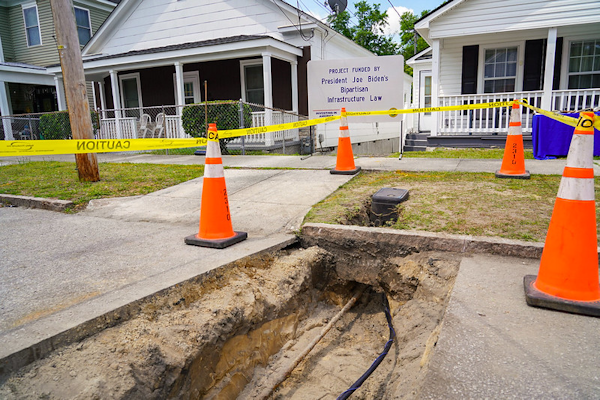SEJournal Online is the digital news magazine of the Society of Environmental Journalists. Learn more about SEJournal Online, including submission, subscription and advertising information.
 |
 |
| A project in Wilmington, North Carolina, to replace an estimated 300,000 lead pipes using $250 million in Bipartisan Infrastructure Law funding via the U.S. Environmental Protection Agency. Photo: U.S. EPA via Flickr Creative Commons (United States government work). |
Reporter’s Toolbox: Tracking the EPA Agenda Through Agency Grants
By Joseph A. Davis
Want to “follow the money?” Try searching out grant data from the U.S. Environmental Protection Agency. This Toolbox has an update on how to do just that.
First, know that grants are the instrument by which the EPA accomplishes much of what it does.
Historically, for instance, the $60 billion program for cleaning up U.S. waterways from sewage discharges in the 1970s and later was done through the Construction Grants Program. That program may be over, but the receipts are still in the database.
These days, grants (really loans) are going out through the Clean Water and Drinking Water State Revolving Funds.
The EPA has tens of billions
more to spend on environmental
grants over the next decade.
More recently, with the enactment of the Inflation Reduction Act and the Bipartisan Infrastructure Law, the EPA has tens of billions more to spend on environmental grants over the next decade.
Most will go to states, municipalities and tribes. But a significant share will go to researchers and to community and advocacy groups in support of environmental justice.
Meanwhile, the EPA has been rolling out a new database for information about the grants it awards. It’s called the Next Generation Grants System. Find general information about the NGGS here or go directly to the online search engine.
Journalists can put it to good use. Even the EPA’s own Office of Inspector General has said the watchdogs should keep an active eye out for waste, fraud and abuse.
Where the data comes from
The EPA’s NGGS grants database comes directly from the agency’s own accounting of the federal dollars that Congress has appropriated for it to spend. So we expect that it will be reliably accurate most of the time.
This database also integrates older databases that you could access via the EPA’s long-running Envirofacts Warehouse. That’s good for data journalists.
One potential weakness of the
grants database is that once a grant
goes on to a state or locality, the EPA may
lose sight of exactly how it is being spent.
One potential weakness of the grants database is that once a grant goes on to a state or locality, the EPA may lose sight of exactly how it is being spent. Grantees do, however, have to report back on their spending.
How to use the data smartly
The extensive search criteria available in the NGGS query engine make it a breeze to do some obvious stuff like finding out grant totals for a particular state, county, city or tribe.
As good as it is, the NGGS query engine is still organized, webwise, under Envirofacts. That system, too, has undergone improvements over the years.
One possible way to check or amplify the EPA’s data is to look for similar data at the state level, since it is often the states that administer the grants. See if you can get any reports that the grantee has submitted.
You can also extend the utility of the new NGGS system by cross-referencing results with other EPA databases and systems. For example, the Facility Registry Service or the EJScreen database (which gives you environmental justice overlays).
As always, we remind you that data reporting alone is usually only part of the journalist’s job. Site visits, interviews, experts … and possibly whistleblowers can add important dimensions to your story. Groundtruth everything.
[Editor’s Note: For more on data reporting through the EPA’s resources, check out recent Toolboxes on agency data on greenhouse gases, water quality, pesticide incidents, wildfire smoke, high-volume chemicals, the Toxics Release Inventory, heat waves and much more on the Reporter’s Toolbox page.]
Joseph A. Davis is a freelance writer/editor in Washington, D.C. who has been writing about the environment since 1976. He writes SEJournal Online's TipSheet, Reporter's Toolbox and Issue Backgrounder, and curates SEJ's weekday news headlines service EJToday and @EJTodayNews. Davis also directs SEJ's Freedom of Information Project and writes the WatchDog opinion column.
* From the weekly news magazine SEJournal Online, Vol. 9, No. 25. Content from each new issue of SEJournal Online is available to the public via the SEJournal Online main page. Subscribe to the e-newsletter here. And see past issues of the SEJournal archived here.










 Advertisement
Advertisement 


